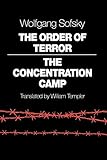The Order of Terror : The Concentration Camp / Wolfgang Sofsky.
Material type: TextPublisher: Princeton, NJ : Princeton University Press, [2013]Copyright date: ©1996Edition: Course BookDescription: 1 online resource (368 p.) : 3 line illus. 4 tablesContent type:
TextPublisher: Princeton, NJ : Princeton University Press, [2013]Copyright date: ©1996Edition: Course BookDescription: 1 online resource (368 p.) : 3 line illus. 4 tablesContent type: - 9780691006857
- 9781400822188
- Camps de concentration -- Aspect psychologique
- Camps de concentration -- Allemagne -- Histoire
- Concentratiekampen
- Concentration camps -- Psychological aspects
- Concentration camps -- Germany -- History
- Concentration camps
- Derde Rijk
- Guerre mondiale (1939-1945) -- Camps de concentration -- Allemagne
- Nazi concentration camps -- Psychological aspects
- Nazi concentration camps -- Germany -- History
- Nazi concentration camps
- World War, 1939-1945 -- Concentration camps -- Germany
- HISTORY / Europe / Germany
- 940.5318 23
- DD256.5
- online - DeGruyter
- Issued also in print.
| Item type | Current library | Call number | URL | Status | Notes | Barcode | |
|---|---|---|---|---|---|---|---|
 eBook
eBook
|
Biblioteca "Angelicum" Pont. Univ. S.Tommaso d'Aquino Nuvola online | online - DeGruyter (Browse shelf(Opens below)) | Online access | Not for loan (Accesso limitato) | Accesso per gli utenti autorizzati / Access for authorized users | (dgr)9781400822188 |
Frontmatter -- Contents -- Tables and Figures -- Acknowledgments -- Part I. INTRODUCTION -- 1. Entry -- 2. Absolute Power -- 3. On the History of the Concentration Camps -- Part II. SPACE AND TIME -- 4. Zones and Camp Plans -- 5. Boundary and Gate -- 6. The Block -- 7. Camp Time -- 8. Prisoner's Time -- Part III. SOCIAL STRUCTURES -- 9. The SS Personnel -- 10. Classes and Classifications -- 11. Self-Management and the Gradation of Power -- 12. The Aristocracy -- 13. Mass, Exchange, Dissociation -- Part IV. WORK -- 14. Work and Slavery -- 15. The Beneficiaries -- 16. Work Situations -- Part V. VIOLENCE AND DEATH -- 17. The Muselmann -- 18. Epidemics -- 19. Terror Punishment -- 20. Violent Excesses -- 21. Selection -- 22. The Death Factory -- Epilogue -- Selected Glossary and Abbreviations -- Abbreviations Used in Notes and Bibliography -- Notes -- Bibliography
restricted access online access with authorization star
http://purl.org/coar/access_right/c_16ec
During the twelve years from 1933 until 1945, the concentration camp operated as a terror society. In this pioneering book, the renowned German sociologist Wolfgang Sofsky looks at the concentration camp from the inside as a laboratory of cruelty and a system of absolute power built on extreme violence, starvation, "terror labor," and the business-like extermination of human beings. Based on historical documents and the reports of survivors, the book details how the resistance of prisoners was broken down. Arbitrary terror and routine violence destroyed personal identity and social solidarity, disrupted the very ideas of time and space, perverted human work into torture, and unleashed innumerable atrocities. As a result, daily life was reduced to a permanent struggle for survival, even as the meaning of self-preservation was extinguished. Sofsky takes us from the searing, unforgettable image of the Muselmann--Auschwitz jargon for the "walking dead"--to chronicles of epidemics, terror punishments, selections, and torture. The society of the camp was dominated by the S.S. and a system of graduated and forced collaboration which turned selected victims into accomplices of terror. Sofsky shows that the S.S. was not a rigid bureaucracy, but a system with ample room for autonomy. The S.S. demanded individual initiative of its members. Consequently, although they were not required to torment or murder prisoners, officers and guards often exploited their freedom to do so--in passing or on a whim, with cause, or without. The order of terror described by Sofsky culminated in the organized murder of millions of European Jews and Gypsies in the death-factories of Auschwitz and Treblinka. By the end of this book, Sofsky shows that the German concentration camp system cannot be seen as a temporary lapse into barbarism. Instead, it must be conceived as a product of modern civilization, where institutionalized, state-run human cruelty became possible with or without the mobilizing feelings of hatred.
Issued also in print.
Mode of access: Internet via World Wide Web.
In English.
Description based on online resource; title from PDF title page (publisher's Web site, viewed 30. Aug 2021)


